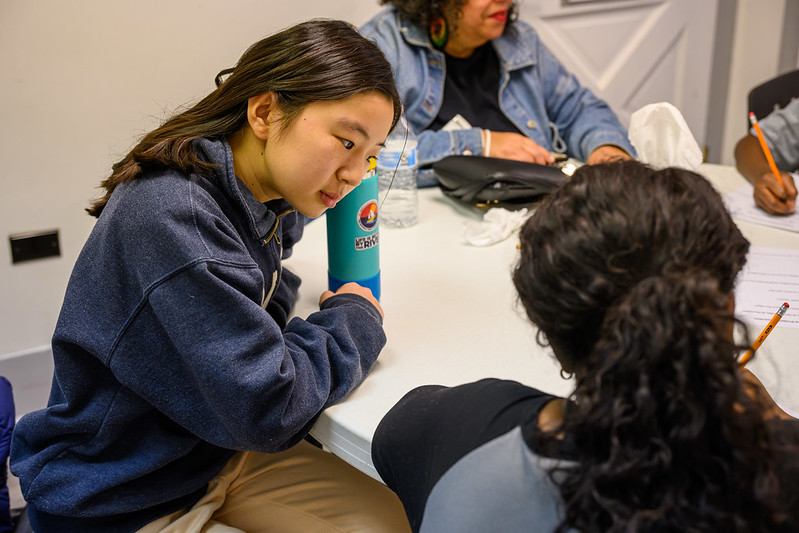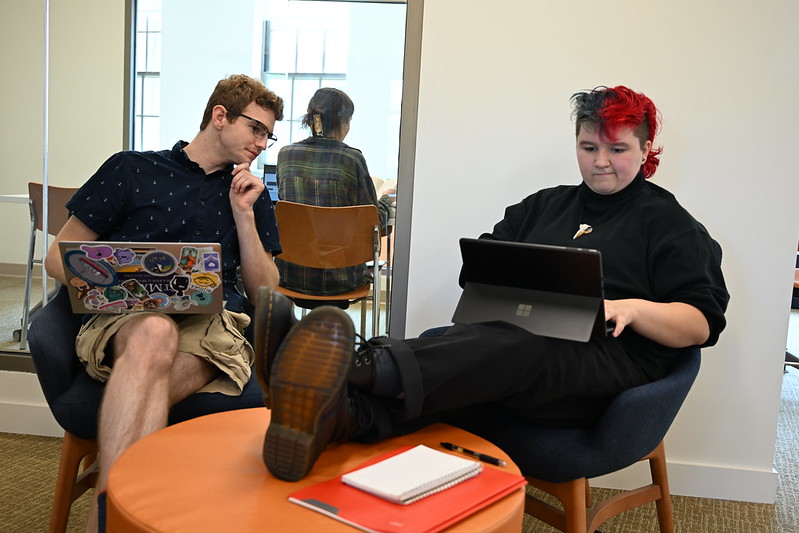Build bridges between subjects.
At St. Mary’s College, students who are interested in more than one subject can create a student-designed major (SDM). This lets them mix classes from different areas to focus on a topic they care about. It’s a way to go deep into a subject while also learning from different points of view.
These majors help students ask big questions and solve complex problems. Like other majors, SDMs include classes that lead to research, internships, and a final project called the St. Mary’s Project.
Some students build their majors from programs like environmental studies, neuroscience, or women, gender & sexuality studies. Others create unique paths.

94%
career outcome rate: employed, in school, volunteering, or in the military (Class of 2023)
29
Study Abroad programs for students
10:1
SMCM's student-to-faculty ratio supports students through their time on campus and beyond

Student-Designed Major
A student-designed major must be a clear and organized plan that includes classes from at least three different subject areas. One of these subjects should be the main focus of the major. The major should follow the same rules as other majors, giving students both a wide range of knowledge and deep understanding, while staying true to the goals of a liberal arts education.
Getting Started
A student-designed major starts with a conversation. If you’re interested in creating your own major, talk to your academic adviser or faculty who knows about your topic. You can also talk to professors who lead programs related to your idea.
If you’re not sure who to talk to or want more general info about how SDMs work, reach out to the associate vice president for academic affairs. When you meet with someone, be ready to:
- Talk about your SDM idea and why you’re interested in it
- Ask if other faculty might be helpful for your major
- Work on improving your plan
- Start thinking about which classes to include in your major
Is it right for me?
Designing your own major takes extra work. Instead of following a set plan like other majors, you’ll create your own and write a proposal.
You won’t do it alone—faculty members will help you and guide you through the process.
Your major must match the goals of your chosen courses, and those courses must already be offered at the college. For example, you can study nutrition through biology and culture, but not through food service or farming, since we don’t have classes in those areas.
Student Eligibility
Students must propose a Student-Designed Major before earning 56 credits. First-year students need approval by the end of their sophomore spring. Transfer students with over 56 credits must get approval in their first semester at St. Mary’s.
You must have at least a 2.5 GPA to submit a proposal. Designing your own major takes extra work, so if your GPA is below 2.5, focus on improving your grades first.
Proposal & Approval Process
All student-designed majors (SDMs) need a written proposal and must go through an approval process. The final step is a review by the Curriculum Review Committee (CRC).
To submit a proposal, you need an advisory committee of at least two faculty from different areas that will be part of your major. This committee helps you create your major.
You will also work with the associate vice president for academic affairs. They help you write your proposal, get approval from your advisory committee, and guide you through the approval process.
The SDM Advisory Committee
The advisory committee for a Student-Designed Major is made up of teachers from the areas that are part of the major. Students should choose these teachers early because they help create the major and the proposal. The Associate Vice President for Academic Affairs can help find the right teachers for the committee.
Teachers join the advisory committee when a student asks them. They must agree to help and approve the final proposal by telling the Associate Vice President for Academic Affairs.
The SDM Proposal
A Student-Designed Major needs a written proposal explaining why the major matters and which courses are included.
The proposal should be clear and include:
- Learning outcomes: What you’ll learn, written by your advisory teachers.
- Major description: What the major is about, what each subject adds, and why you need a Student-Designed Major instead of a regular major. You can add a few keywords.
- Your interest: Why you want this major and how it fits your future plans. You can get help from the Career Development Center.
- Course list: All courses with subject, number, and title. Mark completed courses with an asterisk and include grades. You need 8 credits of St. Mary’s Project work.
- Fieldwork/internships: Any planned research, internships, or study trips.
- Project ideas: Topics you want to explore in your St. Mary’s Project and how your courses prepare you.
SDM Proposal Approval Process
After you write your proposal, the Associate Vice President reviews it and suggests changes if needed.
Your advisory committee signs the final proposal to show support.
You submit it through a Google form. The Curriculum Review Committee (CRC) reviews and votes to approve, deny, or approve with changes. If changes are needed, you’ll be notified.
You’ll get an email with the decision. If approved, you’ll receive a letter with next steps. The Registrar updates your major and assigns your advisors.
If not approved, the CRC will suggest next steps. If approved with conditions, your committee will help you fix it before final approval.
Managing Approved Student-Designed Majors
After the major is approved, your advisory committee members become your academic advisors—one main and one secondary. You must meet with them at least once each semester and schedule the meetings yourself.
If a member leaves, you and your committee will find a replacement, and you’ll ask the new teacher to join.
You need a C- or better in all major courses to graduate. Minor course changes can be approved by your committee; bigger changes need CRC approval.
A shared Google folder will hold your approved proposal, approval letter, and course list.
All majors require a St. Mary’s Project (SMP). Talk about your SMP plans with your advisors by January of your junior year. Register SMPs either under IDIS 493/494 or the relevant department. Follow the department’s approval process.
Apply to graduate in your senior year. Your main advisor will check your transcript and confirm you’ve completed your major.
Honors College Promise
Expand your learning beyond the classroom with opportunities like studying abroad, internships, hands-on classes, or independent research. These experiences help you see the bigger picture.
At St. Mary’s College of Maryland, you’ll benefit from experienced professors, unlike at larger universities where teaching assistants may lead classes. You’re more likely to have the same professor for multiple courses, work with them on your St. Mary’s Project, or have them as your academic adviser.
When you need letters of recommendation for jobs or grad school, you’ll have professors who know you well and can write strong, detailed letters. This close relationship between faculty and students makes your experience at St. Mary’s College unique compared to larger schools.

Contact the Student-Designed Program Adviser.

LATEST NEWS
"QUOTE BODY"
- QUOTE ATTRIBUTION
Student-Designed Chinese, French, or Latinx and Latin American Studies Major
MAJOR BLURB
Courses Offered
Student-Designed Chinese, French, or Latinx and Latin American Studies Courses
- Student-Designed Chinese, French, or Latinx and Latin American Studies Courses>
Student Designed Minor
MINOR BLURB
Connect with Your Program Chair
All the faculty here at St. Mary's College of Maryland want to help you explore your interests and set you up for success. We look forward to connecting with you and meeting you on campus.

